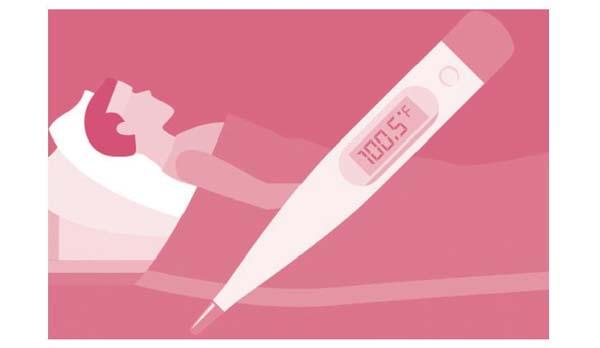A Cultural History of the Fever 发烧文化史
2020-08-07阿德里安娜·拉弗朗斯
阿德里安娜·拉弗朗斯

For most of human history, an unusually high body temperature was a sign of the supernatural. Fevers were sinister1 but common, unnatural but real.
Ancient Romans had at least three temples dedicated to worshipping a god of fever. According to a 1918 issue of The Classical Weekly, Romans would leave amulets2 in these structures of febris3, hoping to placate the deities who made them sick.
In the Middle Ages, fever treatments included incantations4, elixirs5, charms6, and exorcisms7. Avicenna, the influential Persian scholar, described the condition as “extraneous heat, kindled in the heart, from which it is diffused to the whole body through the arteries and veins.” In the centuries that followed, fevers retained an air of mysticism.
Fevers were mysterious largely because people didnt understand they were a symptom rather than a disease in their own right—but also because of their seemingly paradoxical8 qualities. A person who is febrile feels hot to the touch, but experiences bouts9 of shivering cold. Someone with a very high temperature can get well without intervention, whereas the condition of a person with milder fever can seem to suddenly deteriorate.
“Going back to Hippocrates, people—doctors and their patients—had the conception that fever was the disease itself rather than, say, caused by salmonella, or influenza, or some microbial organism,” said Howard Markel, the director of the Center for the History of Medicine and a professor of pediatrics10 and communicable diseases at the University of Michigan. “Nobody knew about microbes, so fever was considered a disease.”
Generations of doctors tried to treat fevers themselves, not their underlying causes, often with gruesome outcomes. “Particularly with febrile diseases, one of the ideas was that you had unbalanced humors11,” said David Morens, a senior scientific advisor at the National Institute of Allergy and Infectious Diseases. “The idea was that bad humors were causing the disease, or at least the fever, and you had to get rid of the poison.” In the 1700s, patients with febrile diseases were bled, sometimes to death, in an attempt to get rid of toxicity.
Even into the 20th century, as people began to understand that fever was the symptom and not the disease, fever was explicitly connected to how illnesses were described: yellow fever, typhoid12 fever, scarlet fever.
Today, doctors dont treat fevers as much as they attempt to treat a fevers underlying cause, but philosophies on fevers are evolving. As recently as the 1970s, doctors still wondered if inciting fever might help kill off an actual infection. Theres little scientific evidence that a fever can stop a virus, but that idea has persisted, highlighting the sometimes bizarre manifestations of fevers cultural standing.
What, then, is the evolutionary purpose of a fever?
It may simply be a way for humans to know that theyre sick—which is useful not just for the person suffering, but for the community around that person. Consider, for example, what happened during the catastrophic measles epidemic in Fiji in 1875. “These people had never seen an epidemic fever—not ever,” Morens said. “This is a group of people who lived for over 1,000 years on a group of islands. There had never been an epidemic febrile disease there.” And yet they knew how to protect themselves right away.
“First of all, they were terrified—all of the sudden their bodies were turning hot and cold,” Morens said. “They didnt know what it was or why. They thought theyd been bewitched13 by spirits... But they immediately understood the concept of contagion and they started isolating themselves. Theyd never seen a fever before but they immediately recognized it was contagious. Groups of people ran to the highlands and hid until the epidemic went away. In some cases, where people were sick, they locked them up in a village and burned them down and killed them.”
Doctors now know that, with the exception of ultra-high fevers of 10514 or more, a higher temperature does not necessarily mean a person is sicker. Most cultures have abandoned theologic15 interpretations—like the idea that a fever was a sign of the gods striking you down, as ancient Egyptians believed. But a deep-rooted fear of fevers remains, passed down from generations of people who lived with a different understanding of their bodies and their vulnerabilities.
“The idea that fever was a big deal has been around for thousands of years,” Morens said. “Fever was a real disease to people, and we carry that legacy forward.”
在人类历史的大部分时间里,体温异常高都被视为一种超自然现象。发烧虽凶险但却常见,虽反常但却真实存在。
古罗马人至少设有三座神殿专门供奉发烧神。据1918年某期《古典周刊》的文章,罗马人会把护身符放置在这些发烧神殿内,希望能让致病的神灵息怒。
中世纪,治疗发烧的手段包括咒语、丹药、符咒和驱邪术。颇具影响力的波斯学者阿维森纳将发烧描述为“外热在心脏内受激发后,通过动脉和静脉蔓延至全身”。嗣后的几个世纪,发烧一直给人一种神秘莫测的感觉。
过去发烧之所以玄秘难解,很大程度上是因为那时人们不知道发烧本身是症状而非疾病——而另一部分原因是发烧有一些看似自相矛盾的特征:发烧之人体表摸着很热,但却一阵阵打寒战;高烧者可能不治而愈,低烧者病情却似乎会突然恶化。
密歇根大学医学史中心主任、儿科学和传染病学教授霍华德·马克尔说:“回想希波克拉底的时代,那时人们——医生及其病人——认为发烧本身是疾病,而不知道是由沙门氏菌、流感或某种微生物引起的。无人知晓微生物,因此发烧被视为一种疾病。”
一代代医生试图治疗发烧,但都是治标不治本,结果往往很糟。美国国家过敏和传染病研究所高级科学顾问戴维·莫伦斯说:“特别针对发热性疾病,有一种观点认为病因是体液失调:不良体液引发疾病或至少导致发烧,因此必须祛除毒素。”18世纪,为祛除体液中的毒素,医生会给热病患者放血,此举有时导致病人死亡。
即使到了20世紀,人们开始认识到发烧是症状而不是疾病,但描述疾病时还是明确与发烧相关联,例如黄热病、伤寒热、猩红热。
如今,医生对发烧治本重于治标,而关于发烧的观念也在不断嬗变。直到20世纪70年代,医生们还在琢磨让病人发烧是否可能有助于消除真正的感染。几乎没有科学证据证明发烧可遏制病毒,但这种观点一直延续至今,凸显出发烧有时在文化地位上的怪异表现。
那么,从进化角度看,发烧的目的是什么呢?
这或许只是一种让人类知晓自己生病的方法——不仅对病人有用,对他所在的社群也有用。例如1875年斐济的灾难性麻疹疫情,想想当时发生的一切吧。“当地人从未见过流行性发烧——从来没有。”莫伦斯说,“这个族群在群岛上生活了1000多年。当地此前从未发生过流行性热病。”但他们立时就知道了如何保护自己。
莫伦斯说:“他们起初极度惊恐——身体突然忽冷忽热。他们不知道是怎么一回事,也不清楚为什么会这样,还以为自己中邪着魔了……但他们旋即意会到‘传染这一概念,开始自我隔离。他们以前从未见过发烧,却即刻认识到发烧会传染。人们成群结队跑到高地躲藏起来,直到疫情消退。在某些情况下,发现有人生病时,他们会将病人关押在村子里,将其烧死。”
现在,医生们知道,除105华氏度或以上的超高烧以外,体温更高未必意味着病情更重。古埃及人认为发烧是被神灵击倒的征象,诸如此类的神学诠释已被大多数文化所摈弃。然而,对发烧根深蒂固的恐惧依旧存在,这是对自己的身体和弱点有着不同理解的先人一代代流传下来的。
莫伦斯说:“发烧非同小可,这一观点已流传几千年。对人们来说,发燒曾是一种实实在在的疾病,而我们现在要把这种认识向前推进。”
(译者为“《英语世界》杯”翻译大赛获奖者)
1 sinister险恶的,不祥的。 2 amulet护身符,驱邪物。 3 febri热,烧。 4 incantation咒语。 5 elixir灵丹妙药。 6 charm咒文,符咒。 7 exorcism驱邪仪式或法术。
8 paradoxical自相矛盾的。 9 bout发作。 10 pediatrics儿科,儿科学。 11 humor体液。
12 typhoid伤寒的。
13 bewitch使着魔,蛊惑。 14约等于40.5摄氏度。 15 theologic神学的。
